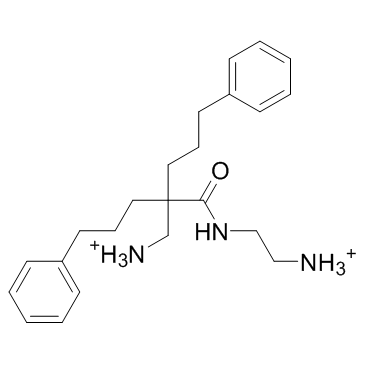LTX-401 |
| Catalog No.GC31860 |
Products are for research use only. Not for human use. We do not sell to patients.

Cas No.: 1398051-86-9
Sample solution is provided at 25 µL, 10mM.
LTX-401, an oncolytic amino acid derivative, targets the Golgi apparatus.
LTX-401, an oncolytic amino acid derivative, targets the Golgi apparatus[2]. LTX-401 effectively reduces the viability of several tumor cell lines in vitro, with a similar degree of cytotoxicity against non-malignant cell lines such as HUV-EC-C endothelial cells, HaCat keratinocytes and MRC-5 fibroblasts. LTX-401 displays the highest cytotoxic activity against the human malignant melanoma cell line MDA-MB-435S (13.5 μM), and is least active against the human hepatocellular carcinoma cell line HEPG2 (35.4 μM). For the remaining cell lines, LTX-401 exhibits similar IC50 values, varying slightly within the range of 19-32 μM. No in vitro hemolytic activity against RBCs is observed using the same concentrations required for the induction of cell death in cancer cell lines. A 50% hemolysis is observed using higher concentrations of LTX-401 (400 μg/mL=1087 μM)[1].
The majority (9/11) of the animals demonstrate a complete and lasting tumor regression after intratumoral treatment with LTX-401. Samples are collected from selected animals in the treatment group and control group on days 2 and 7 post-treatment with a single i.t injection. The immunolabelling of tumor tissue with anti-CD3 antibody reveals that a majority of the infiltrating cells are CD3+ T cells, whereas tumors injected with vehicle only exhibit tumors with a viable tumor tissue, with minimal necrosis and few lymphocytes[1].
[1]. Liv-Marie Eike, et al. The Cytolytic Amphipathic β(2,2)-Amino Acid LTX-401 Induces DAMP Release in Melanoma Cells and Causes Complete Regression of B16 Melanoma. PLoS One. 2016; 11(2): e0148980. [2]. Heng Zhou, et al. The oncolytic compound LTX-401 targets the Golgi apparatus. Cell Death Differ. 2018 Jan; 25(1): 227-228.
Average Rating: 5 (Based on Reviews and 34 reference(s) in Google Scholar.)
GLPBIO products are for RESEARCH USE ONLY. Please make sure your review or question is research based.
Required fields are marked with *




















